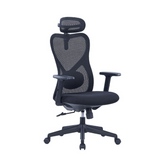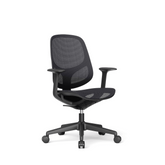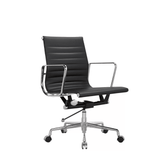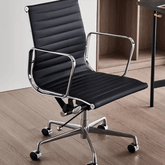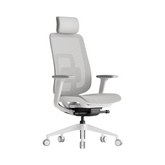Is Buying an Ergonomic Chair Enough?
No matter how hard you work to create the most ergonomic office working environment, even buying the best ergonomic chair, standing desk, footrests, or other equipment, everything will only become superficial if you cannot find the correct sitting posture and desk setup. Prolonged bad posture can lead to serious health problems, causing muscle soreness, weakness, fatigue, increased pressure, spinal issues and neck deformities, shoulder and neck stiffness, and more.
First and foremost, when you sit at your desk all day, the best investment you can make is a good ergonomic chair. It allows you to maintain a good sitting posture and also provides full back support from the ergonomic chair. An ergonomic chair ensures you can adopt both dynamic and healthy sitting postures without additional stress. It doesn't mean you have to buy the most expensive ergonomic chair, but you should choose one with proper adjustment features to lay a good foundation for your workplace health.
Table of Contents
- Is Buying an Ergonomic Chair Enough?
- What is Good Posture?
- Is Just Maintaining a Correct Sitting Posture Foolproof?
- 6 Secrets to Good Sitting Posture for Optimal Office Ergonomics
- How to Properly Set Up Your Desk?
- Develop Habits to Maintain Good Posture
What is Good Posture?
Good posture refers to the state of your body when sitting, standing, or even lying down. Good posture should allow you to move without causing stress or pain. You might have heard good posture described as a straight back, shoulders pulled back, and stomach tucked in. However, good posture is not just about always staying upright; you need to adopt different postures throughout the day based on your tasks. Good posture should be safe, balanced, and allow you to complete your work easily without causing harm to your body. Healthy posture can prevent body misalignment, spinal pain, neck and shoulder pain, poor balance, indigestion, and more, improving your quality of life. Static posture refers to your position when sitting, standing, or lying still; dynamic posture refers to your posture when moving, stretching, or walking. With an ergonomic chair, you can adopt both static and dynamic postures.

So, Is Just Maintaining Correct Sitting Posture Foolproof?
In the article "Standing at Work: Duration and Benefits for Workplace Health", it was mentioned that with an ergonomic office chair, you should be able to adopt both static and dynamic postures. We introduced a new concept of sitting health, "posture variation". When working in a sitting position, it is recommended to switch between upright sitting, reclining, and forward-leaning postures based on work needs,
physical health conditions, or personal preferences. The purpose of posture variation is to change different sitting postures with correct spinal support so that muscle tissues can get proper rotational rest and avoid excessive pressure, thus preventing health problems caused by long-term sitting. Of course, you should maintain an upright posture most of the time, but you can occasionally switch to other postures to relieve muscle pressure.

6 Secrets to Good Sitting Posture for Optimal Office Ergonomics
Practicing healthy sitting posture is crucial when you sit at your desk for part of the day or all day. Not only can it reduce pain and stress, but it also allows you to focus on work without being bothered by discomfort from sitting all day. Now, please sit in your ergonomic chair and refer to the following tips to ensure you maintain a healthy and comfortable posture at your desk.
-
Balance Your Head Using Headrest
Sit in a chair with good lumbar support and keep your head balanced. Avoid leaning your head forward, as this puts unnecessary pressure on your back, neck, and shoulders. Also, ensure the mouse and keyboard are close to you to avoid leaning forward. Keep your elbows close to your body. If your office chair has a headrest, set it at the junction between your head and neck to naturally and comfortably support your head and neck.

-
Keep your back against your seat
Make sure to lean your back against the chair's backrest to avoid leaning forward, reducing back pressure and pain, while ensuring the chair provides support.

-
Use Lumbar Support
Ensure the lumbar support system is correctly placed at the curve of your spine to provide maximum comfort, allowing you to maintain a healthy posture all day.

-
Adjust the Elbow Angle With the Armrest
Ensure your office chair and desk setup are well-matched. Adjust the seat height or armrest while ensuring your arms form a 90-degree angle with the desk. If your desk height is adjustable, adjust both the desk and chair height for the most comfortable setup.

-
Place Your Legs Correctly
Keep your knees at a 90-95 degree angle, with your feet flat on the floor or on a footrest. Avoid stretching or bending your legs. Ensure there is a two-finger width gap between the back of your knees and the front of the seat.

-
Use Recline Function
If your office chair's backrest can unlock the angle lock and has corresponding tension adjustment functions, you should use the unlocked backrest to use the free recline function, allowing your body to switch between dynamic and static postures, giving muscle tissues appropriate rotational rest and avoiding excessive pressure. Adjust the recline tension higher to ensure the backrest still provides support for your back.

How to Properly Set Up Your Desk?
Besides sitting posture, the design of your desk is also an important part of ergonomics. Your monitor, keyboard, mouse, and other equipment are part of your desk setup. Using them correctly with proper posture also significantly impacts your workplace health.
-
Correctly Adjust Monitor Position
When using a computer or laptop, try to align the top of the monitor with your eyes and adjust the screen to be about 15 degrees below horizontal eye level. You can also use an adjustable monitor stand as an aid. This can help avoid strain on your eyes and neck. If you use two monitors, place the joint of the monitors directly in front of you. Whenever possible, rotate your chair instead of your head.
If you frequently look at only one of the two monitors, place the primary monitor directly in front of you and the other one as close to you as possible. If you use a laptop, try using an external display or place the laptop on a stand and use an external mouse and keyboard.
-
Properly Position Keyboard and Mouse
The keyboard and mouse should be placed directly in front of the monitor, and they should be at a height where your arms can comfortably operate them at a 90-degree angle to the desk. The keyboard and mouse should be at the same height. You can use a keyboard with adjustable height and tilt to keep your wrists in a more natural position.
-
Remind Yourself to Take Breaks or Change Posture Regularly
If you find it hard to get up and move around the office, unlock the recline function of your chair to stretch your body. It's recommended to take a short break or change posture every 30 minutes.
If you have a standing desk, stand for 15-20 minutes every 2 hours. Remember, standing all day is not better than sitting all day. Your body needs various postures for optimal comfort.

Develop Habits to Maintain Good Posture
We recommend good posture not because it looks good or professional, but because it is beneficial. Practicing healthy posture has many health benefits and makes your time at your desk more comfortable. Good posture can also increase energy levels, strengthen core muscles, aid respiratory function, improve circulation and digestion, and enhance mood. Most importantly, develop the habit of truly letting your ergonomic chair fulfill its role in providing support for your body.
